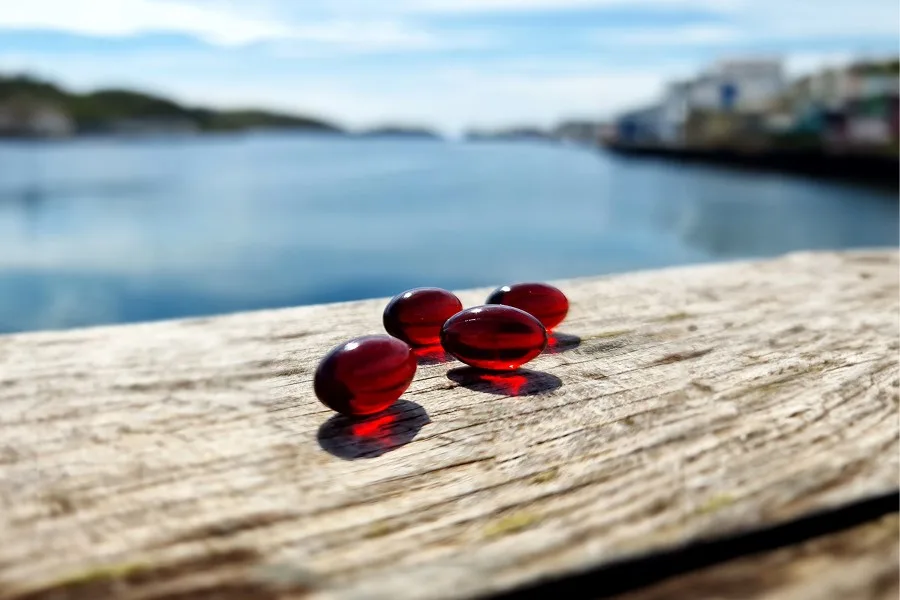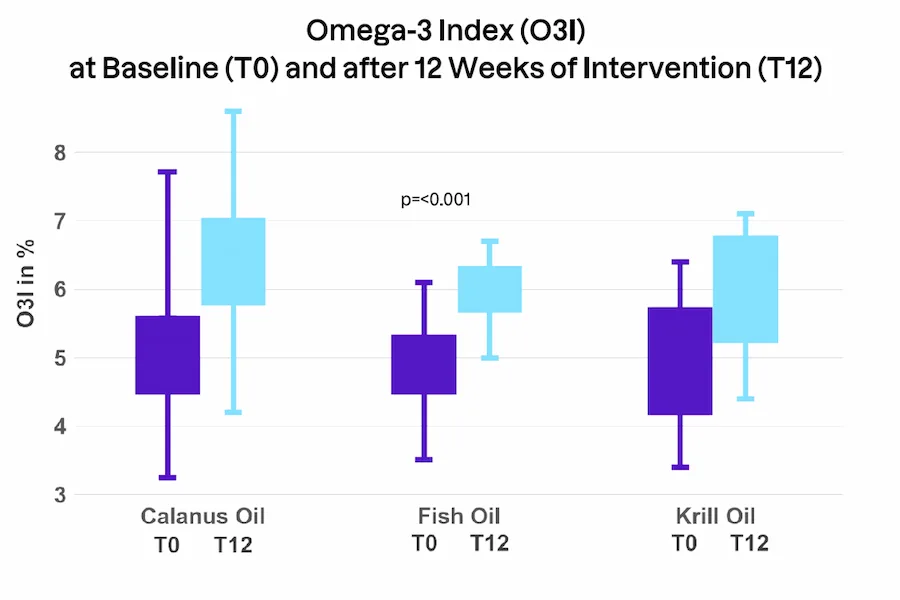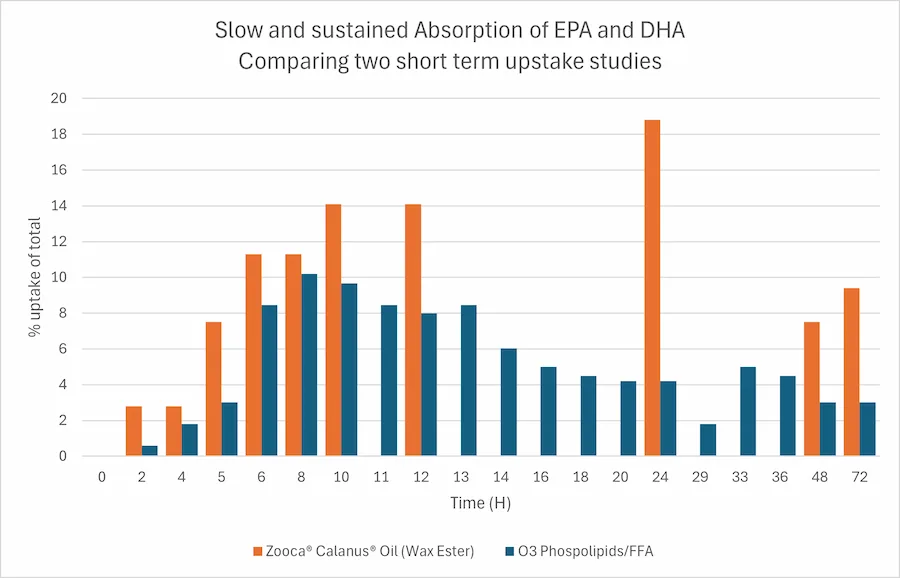
Fatty Acid Bioavailability and Delayed Absorption – Why It Matters
When discussing omega-3 supplements, the conversation usually centers around how much EPA and DHA the body can absorb and how quickly. But an equally important question is where and when these fatty acids are absorbed and made bioavailable for health benefit. This timing effect, known as slow release, is a defining feature of the unique benefits of Zooca® Calanus® Oil.
Fatty Acid Bioavailability: Comparable to Fish and Krill Oil
Most omega-3 studies use the Omega-3 Index (O3I) as a measure of status for omega-3 levels in the body. In a 12-week study, Zooca® Calanus® Oil, fish oil (rTAG), and krill oil (phospholipids) showed comparable improvements in O3I (Vossköter et al., 2023). This demonstrates that over time, Zooca® Calanus® Oil delivers total EPA and DHA as effectively as other well absorbed omega-3 sources. All three sources demonstrate similarly high EPA and DHA bioavailability compared to each other.

Short term (Acute) Studies Reveal a Different Story
Short-term studies measure the rate of omega-3s being incorporated in the blood, often over 72 hours following intake of a single dose. Here is where Zooca® Calanus® Oil stands out with a clearly slower uptake rate of omga-3s compared to other formulations.
Short-term studies track how fast EPA and DHA appear in the blood after a single dose, and these studies have been carried out to highlight differences between omega-3 forms. The nature of lipid digestion is complex in particular when it comes to comparing the rate of absorption in terms of EPA and DHA from different substates as fish oil (rTG or ethyl ester), krill oil and calanus oil (Pedersen et al. 2016; Dahlheim et al. 2020). Some differences are nevertheless seen:
- Phospholipid oils and free fatty acids (FFA) peak quickly, often within the first 6–8 hours (Lapointe et al 2019).
- Triglycerides (rTAG) also peak relatively quickly.
Wax esters, like those in Zooca® Calanus® Oil, peak later than the two formulations above. While the exact peak time cannot be determined due to limited sampling, studies consistently show that EPA and DHA levels continue to rise beyond 8 hours after intake and may extend well into the following day (Cook et al., 2016).
These unique profiles are rooted in the digestion or absorption in the fats, collectively measured as differences in timing of the release of EPA and DHA into the human blood stream. The wax esters in Zooca® Calanus® Oil stand out to have a slow release of EPA and DHA compared to these other forms (Figure 2).

Why Does This Matter?
Human digestion is a long process. Food can pass through the stomach in less than two hours, but it can remain in the small intestine, the key site for nutrient absorption, for another six hours or more. A rapid spike of EPA and DHA can therefore “run ahead” of the digestive process. By contrast, the slower digestion and absorption from Zooca® Calanus® Oil ensures that omega-3s remain available throughout the full digestive timeline as it transports to the distal intestines, a place where most omega-3s never reach.
In practical terms, this means nutrients are:
- available for longer, not just in a short peak
- better aligned with the body’s own rhythm of digestion and absorption
- able to reach fatty acid receptors in the distal part of the small intestine and the colon
- continuously supporting metabolic processes rather than delivered in a rapid burst
From Nutrients to Signals
Free fatty acids do more than supply building blocks for energy and cell membranes. They also act as messengers. In the gut and other tissues, they bind to Free Fatty Acid Receptors (FFARs), which in turn stimulate the release of digestive peptides, including GLP-1 – a hormone central to insulin secretion, appetite regulation, and fat metabolism (Ulven & Christensen, 2015).
EPA and DHA are strong activators of these receptors. Stearidonic acid (SDA), another omega-3 component of Zooca® Calanus® Oil, shows even higher affinity. By extending the absorption window of these fatty acids, Zooca® Calanus® Oil potentially sustains receptor activation over a longer period, with implications for areas such as weight management and metabolic health.
Why It Matters for the Supplement Industry
For research and development, Zooca® Calanus® Oil shows equivalent long-term omega-3 status compared to fish and krill oil. What sets it apart is the distinctive delayed absorption profile of its wax esters, extending the availability of EPA and DHA beyond eight hours. This creates new opportunities to study links between nutrient release, GLP-1 stimulation, and other metabolic pathways relevant to obesity, diabetes, and energy regulation.
For commercial teams, this is a strong differentiation point. In a market where many omega-3 products look and act alike, Zooca® Calanus® Oil can be positioned as the only source that offers slow release by nature – a story that is both scientifically documented and easy to communicate. Instead of a quick spike, the product delivers a steady, sustained supply of omega-3s, naturally aligned with human digestion and metabolism, and it activates fatty acid receptors found in the distal intestines.
That makes it a compelling proposition for brands and partners looking to stand out with science-driven innovation.
In Summary
Zooca® Calanus® Oil is not just another omega-3. Its wax ester structure provides:
- Equivalent long-term bioavailability to fish and krill oil
- A gradual, delayed absorption and bioavailability of EPA and DHA beyond eight hours
- A natural alignment with digestive and metabolic processes
By combining proven bioavailability with a unique release profile, Zooca® Calanus® Oil offers a new dimension in omega-3 nutrition – steady, sustained, and designed by nature.
References:
Vosskötter F, Burhop M, Hahn A, Schuchardt JP. (2023) Equal bioavailability of omega-3 PUFA from Calanus oil, fish oil and krill oil: A 12-week randomized parallel study. https://aocs.onlinelibrary.wiley.com/doi/10.1002/lipd.12369
Pedersen, A. M. (2016). Calanus® oil. Utilization, composition and digestion. https://munin.uit.no/handle/10037/9759
Dalheim, L. Svenning, J.B., Olsen, R. L. (2023). In vitro intestinal digestion of lipids from the marine diatom Porosira glacialis compared to commercial LC n-3 PUFA products. https://doi.org/10.1371/journal.pone.0252125
Lapointe, J-F., Harvey, L., Pharm, B., Aziz, S., Jordan, H., Hegele, R. A. Lemieux, P. (2019). A Single-dose, Comparative Bioavailability Study of a Formulation containing OM3 as Phospholipid and Free Fatty Acid to an Ethyl Ester Formulation in the Fasting and Fed States. https://doi.org/10.1016/j.clinthera.2019.01.017
Cook, C.M., Larsen, T., Derrig, L.D., Kelly, K.M. and Tande, K.S. (2016). Wax-ester rich oil from the marine crustacean Calanus finmarchicus is a bioavailable source of EPA and DHA for human consumption. https://doi.org/10.1007/s11745-016-4189-y T Ulven, E Christiansen - Annual Review of Nutrition, (2015). Dietary fatty acids and their potential for controlling metabolic diseases through activation of FFA4/GPR120. https://doi.org/10.1146/annurev-nutr-071714-034410

